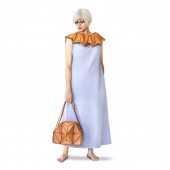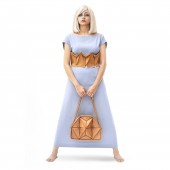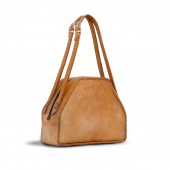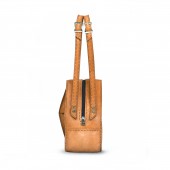
| THE AWARD |
| CATEGORIES |
| REGISTRATION |
| SUBMIT YOUR WORK |
| ENTRY INSTRUCTIONS |
| TERMS & CONDITIONS |
| PUBLICATIONS |
| DATES & FEES |
| METHODOLOGY |
| CONTACT |
| WINNERS |
| PRESS ROOM |
| GET INVOLVED |
| DESIGN PRIZE |
| DESIGN STORE |
| THE AWARD | JURY | CATEGORIES | REGISTRATION | PRESS | WINNERS | PUBLICATIONS | ENTRY INSTRUCTIONS |
Sarban Leather Bag by Aida Mehranfar |
Home > Winners > Design #152080 >Interview |
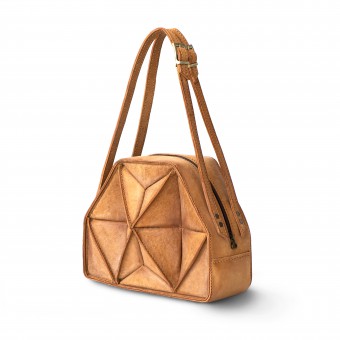 |
|
FS: What is the main principle, idea and inspiration behind your design?
AM: I have been inspired by the architectural form of an old Iranian building located in Isfahan to design the Sarban bag. This building is a minaret located in a neighborhood that houses people of three different religions. This topic was very interesting to me. that different religions live together. That's why I chose this building for the main idea. This building is used to see the founders of desert caravans during the Seljuk era of Iran. For this reason, it is called Sarban, and I gave the same name to the design that inspired me.
FS: What has been your main focus in designing this work? Especially what did you want to achieve?
AM: I focused on two themes in this work. First, to be able to create a design inspired by Iranian architecture. Because Iran has a very rich architectural history and I wanted to show it at the international level. To reflect the art and culture of my country and to achieve a minimal design inspired by traditional Iranian architecture and its integration with modern art so that it can both reflect the culture and art of my country and have the ability to communicate with the modern world. The second topic I wanted to reach was the reflection of the message of peace. Because I explained in the previous question, Sarban conveys the message of peace. For this reason, I was inspired by a music composed by my composer friend Behrouz Paygan, and this song is called "Peace Smell". Because I am a designer who mostly draws inspiration from music, and music is one of my sources of inspiration in the field of my artistic activity.
FS: What are your future plans for this award winning design?
AM: I really hope that I can find a connection with different nations by introducing Sarban to the international community. Because I have a long term in mind, Sarban is the starting point. That's why I participated in this competition so that I can carry out the caravan of my future plans and ideas through Sarban.
FS: How long did it take you to design this particular concept?
AM: Designing Sarban was not an easy task. I went through a lot of trial and error to find the right pattern to present this design. Sarban Minaret has many embossed and recessed motifs on its top, which are displayed by bricks. Summarizing these motifs and turning them into simpler motifs and reaching a form that provides the right quality is a time-consuming task. I wasn't sure this design would work until I ran the original with leather. But making the prototype and the result was very enjoyable for me.
FS: Why did you design this particular concept? Was this design commissioned or did you decide to pursuit an inspiration?
AM: This was not a custom design. I designed it for the first time for the first Iranian national fashion festival and won the top three positions for the Sarban design. The theme of the festival was inspired by Iranian architectural monuments. After many searches to choose a suitable architectural building for inspiration, I was attracted by Sarban's design and chose it for inspiration.
FS: Is your design being produced or used by another company, or do you plan to sell or lease the production rights or do you intent to produce your work yourself?
AM: Since I have been working in the field of designing and producing hand-stitched leather bags for about twelve years, I am in charge of it myself. I am the owner of the Fida brand, and with this brand name, I bring all my designs to the production stage.
FS: What made you design this particular type of work?
AM: My job is to design and produce leather bags, and Sarban is not the only bag I have ever designed. My interest in bags and design made me work in this field.
FS: Who is the target customer for his design?
AM: Fida has special customers for its special designs. People who like to be different from others and carry a special message with them. Those who don't look at the bag as just a means of carrying their daily things and like to have a different look are Sarban's target.
FS: What sets this design apart from other similar or resembling concepts?
AM: Sarban carries messages: the message of peace, a reflection of Iranian art and culture. In my opinion, objects that we relate to and can use in our daily lives can be more than tools if they have meaning and history. Sarban is a bag that carries the history of a culture and at the same time the message of peace.
FS: How did you come up with the name for this design? What does it mean?
AM: Sarban is the name of the minaret that inspired me for the design. The literal meaning of this word in Persian language is: "The sarban or caravan leader was an experienced and skilled person who was responsible for guiding and leading the caravan on land trade routes, such as the Silk Road. "Sarbans were usually familiar with trade routes, possible dangers, and safe places to rest and rest, including caravansaries along the way." As this bag was among the winners of this competition, it can lead FIDA's goals to its destination like another bag. In fact, Sarban can be the starting point of Fida's movement towards progress and reaching the goal.
FS: Which design tools did you use when you were working on this project?
AM: At that time, I used drawing tools such as paper and pen to design this work. From the beginning to the end, everything is done by hand, even the implementation of the bag.
FS: What is the most unique aspect of your design?
AM: Perhaps the most unique aspect of my design is being inspired by music. I can make volume out of sound and use it to produce bags that carry different messages.
FS: Who did you collaborate with for this design? Did you work with people with technical / specialized skills?
AM: I did not collaborate with anyone to design and produce the bag itself, and I did all the steps myself. But the music I was inspired by is my friend and fellow composer Mr. Behrouz Paygan.
FS: Is your design influenced by data or analytical research in any way? What kind of research did you conduct for making this design?
AM: For this project, I needed to search a lot in the history of Iranian art. Also, research on the architecture of the Seljuk period, to express the art of that period and its integration with modern art.
FS: How did you decide to submit your design to an international design competition?
AM: I used Sarban's plan and its introduction so that I could have a start to introduce myself at the international level. I had heard a lot about the A design award competition and since I am interested in the country of Italy, I decided to try my luck and I am glad that I got a good answer.
FS: What did you learn or how did you improve yourself during the designing of this work?
AM: Sarban's design helped me to get a more detailed view of Iranian architectural art, and this made me learn to look deeply. This helped me a lot for the designs I did after Sarban. Also, making the Sarban pattern was one of the most difficult stages of its production, and by doing it, I was able to improve my pattern making skills. Actually, the design and implementation of Sarban was a difficult challenge for me and I am happy that I was able to overcome it.
FS: Thank you for providing us with this opportunity to interview you.
A' Design Award and Competitions grants rights to press members and bloggers to use parts of this interview. This interview is provided as it is; DesignPRWire and A' Design Award and Competitions cannot be held responsible for the answers given by participating designers.
| SOCIAL |
| + Add to Likes / Favorites | Send to My Email | Comment | View Press-Release |

